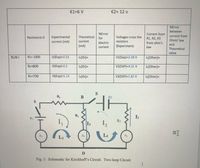
Introductory Circuit Analysis (13th Edition)
13th Edition
ISBN: 9780133923605
Author: Robert L. Boylestad
Publisher: PEARSON
expand_more
expand_more
format_list_bulleted
Concept explainers
Question

Transcribed Image Text:RUN 1
1.
Connect the two-loop circuit as illustrated in Fig. 1, with three variable boxes and two DC supplies. Choose
the following values for the resistors and the power supplies: R3 = 700 Q, R, = 1000.2, R2 = 800 2,
ɛj=6 V and ɛ2=12 V. Record these values in Table 1.
2.
After the circuit has been checked, close the switches
3. Measure the currents I3,I,1, through resistors and the voltage V3,V, ,V½ across each resistor of the
circuit. Record these values in Data Table 1. Assuming that only one ammeter will be used, currents
through the resistors will be measured one at a time by placing the ammeter in series with the resistor.
After the ammeter has been connected, turn on the power supplies and record current.

Transcribed Image Text:€1=6 V
€2= 12 v
%Error
between
%Error
Current from
current from
Experimental
current (mA)
Resistance Q
Theoretical
for
Voltages cross the
R1, R2, R3
from ohm's
Ohms' law
current
resistors
electric
and
(mA)
current
(Experiment)
law
Theoretical
value
RUN I
R1= 1000
1(Exp)=2.53
1(th)=
V1(Exp)=2.58 V
a(Ohm)=
R2=800
12(Exp)=2.5
I2(th)=D
V2(EXP)=D4.31 V
2(Ohm)=
R3=700
13(Exp)=5.14
Ia(th)=
V3(EXP)=1.82 V
I3(Ohm)=
S
R,
82
I2
R3
L2
Fig. 1: Schematic for Kirchhoff's Circuit. Two-loop Circuit
Expert Solution
This question has been solved!
Explore an expertly crafted, step-by-step solution for a thorough understanding of key concepts.
This is a popular solution
Trending nowThis is a popular solution!
Step by stepSolved in 4 steps

Knowledge Booster
Learn more about
Need a deep-dive on the concept behind this application? Look no further. Learn more about this topic, electrical-engineering and related others by exploring similar questions and additional content below.Similar questions
- Please help!!!arrow_forwardHolds list UACO 50 V R1 = 10 ohms R2 = R3 = 25 ohms 15 ohms A. This is a circuit. ohms. (Round your answer to one decimal place.) B. The total resistance of this cirucit is amps. (Round your answer to one decimal place.) C. The total current flow in this circuit is amps.(Round your answer to the enarest whole number.) D. The current flow through R1 is volts. (Round your answer to the nearest whole number.) E. The voltage across R2 isarrow_forwardElectrical Engineering For the final problem, consider the following circuit diagram: 12 Q 30 V Vx 60 Q 2"Vx B 6) For this circuit, please find and draw: a. The Thevenin equivalent circuit between A and B, using external excitation to find R. b. The Norton cquivalent circuit berween A and B. c. Review section 3-8 from the text. What value load resistor connected between A and B would yield maximum power transfer? How much power woukd this be?arrow_forward
arrow_back_ios
arrow_forward_ios
Recommended textbooks for you
 Introductory Circuit Analysis (13th Edition)Electrical EngineeringISBN:9780133923605Author:Robert L. BoylestadPublisher:PEARSON
Introductory Circuit Analysis (13th Edition)Electrical EngineeringISBN:9780133923605Author:Robert L. BoylestadPublisher:PEARSON Delmar's Standard Textbook Of ElectricityElectrical EngineeringISBN:9781337900348Author:Stephen L. HermanPublisher:Cengage Learning
Delmar's Standard Textbook Of ElectricityElectrical EngineeringISBN:9781337900348Author:Stephen L. HermanPublisher:Cengage Learning Programmable Logic ControllersElectrical EngineeringISBN:9780073373843Author:Frank D. PetruzellaPublisher:McGraw-Hill Education
Programmable Logic ControllersElectrical EngineeringISBN:9780073373843Author:Frank D. PetruzellaPublisher:McGraw-Hill Education Fundamentals of Electric CircuitsElectrical EngineeringISBN:9780078028229Author:Charles K Alexander, Matthew SadikuPublisher:McGraw-Hill Education
Fundamentals of Electric CircuitsElectrical EngineeringISBN:9780078028229Author:Charles K Alexander, Matthew SadikuPublisher:McGraw-Hill Education Electric Circuits. (11th Edition)Electrical EngineeringISBN:9780134746968Author:James W. Nilsson, Susan RiedelPublisher:PEARSON
Electric Circuits. (11th Edition)Electrical EngineeringISBN:9780134746968Author:James W. Nilsson, Susan RiedelPublisher:PEARSON Engineering ElectromagneticsElectrical EngineeringISBN:9780078028151Author:Hayt, William H. (william Hart), Jr, BUCK, John A.Publisher:Mcgraw-hill Education,
Engineering ElectromagneticsElectrical EngineeringISBN:9780078028151Author:Hayt, William H. (william Hart), Jr, BUCK, John A.Publisher:Mcgraw-hill Education,

Introductory Circuit Analysis (13th Edition)
Electrical Engineering
ISBN:9780133923605
Author:Robert L. Boylestad
Publisher:PEARSON

Delmar's Standard Textbook Of Electricity
Electrical Engineering
ISBN:9781337900348
Author:Stephen L. Herman
Publisher:Cengage Learning

Programmable Logic Controllers
Electrical Engineering
ISBN:9780073373843
Author:Frank D. Petruzella
Publisher:McGraw-Hill Education

Fundamentals of Electric Circuits
Electrical Engineering
ISBN:9780078028229
Author:Charles K Alexander, Matthew Sadiku
Publisher:McGraw-Hill Education

Electric Circuits. (11th Edition)
Electrical Engineering
ISBN:9780134746968
Author:James W. Nilsson, Susan Riedel
Publisher:PEARSON

Engineering Electromagnetics
Electrical Engineering
ISBN:9780078028151
Author:Hayt, William H. (william Hart), Jr, BUCK, John A.
Publisher:Mcgraw-hill Education,